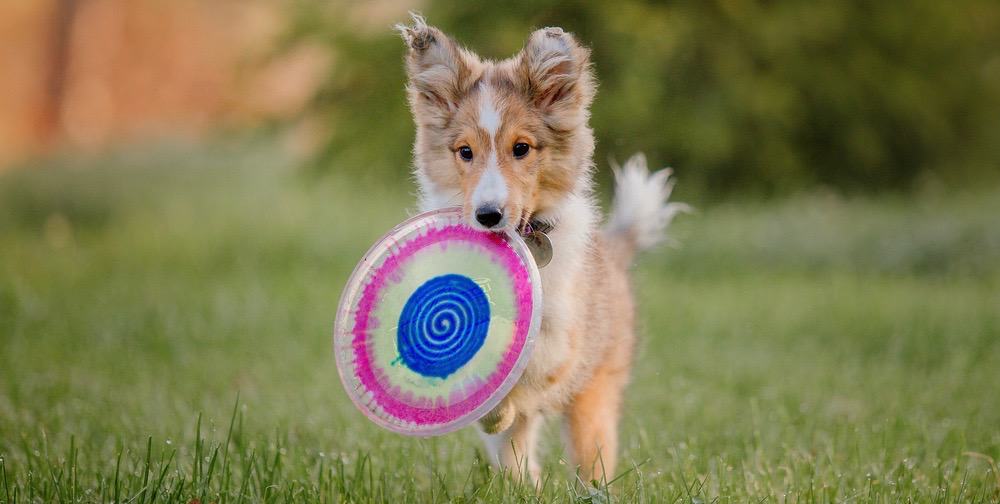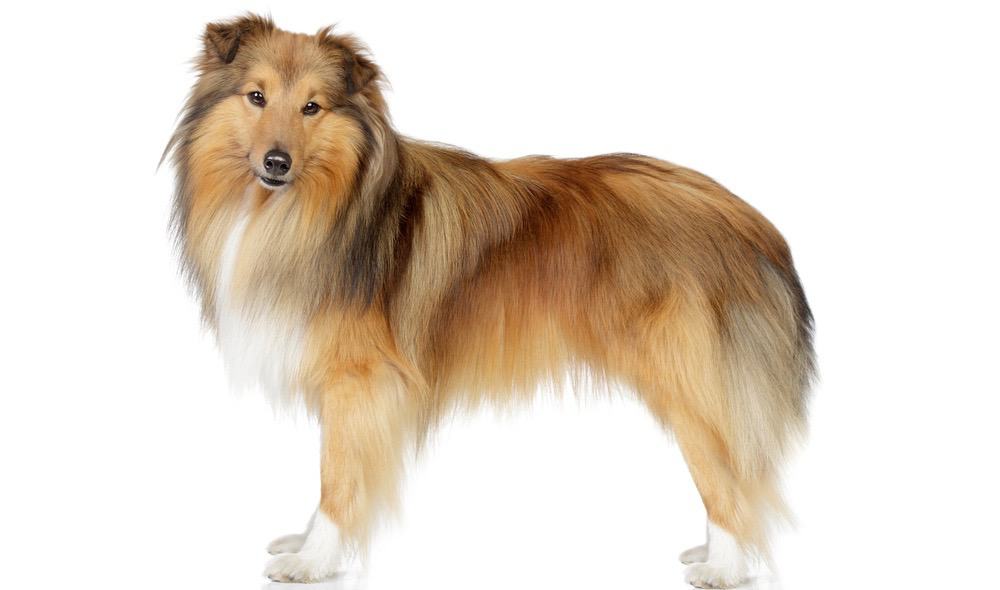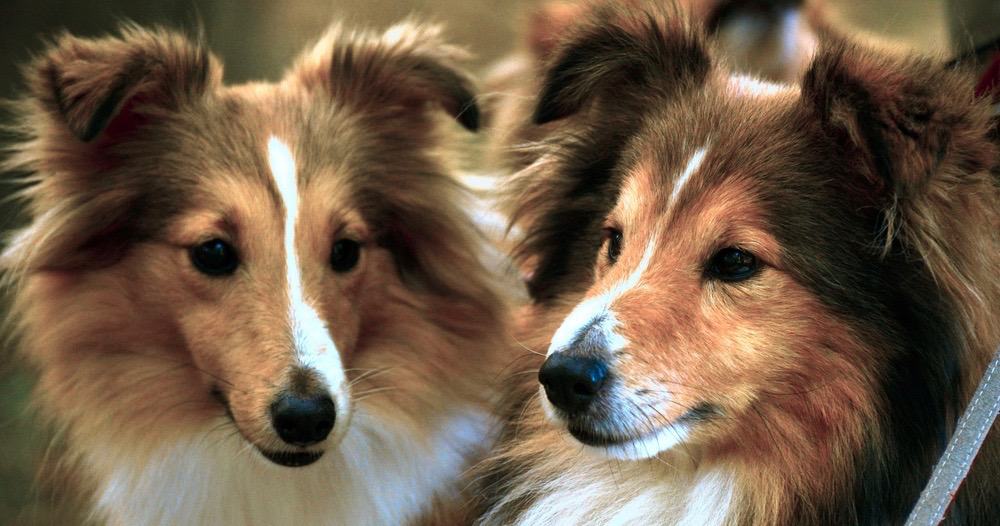Sheltie Growth Chart (Weight Chart) – When Do Shelties Stop Growing
The Shetland Sheepdog, affectionately known as the Sheltie, comes from the Shetland Islands of Scotland. They were originally called Shetland Collie, but since they are not collies at all, and are a completely separate breed, the name was changed.
You can use our Sheltie growth chart as a general guideline of what to expect as your Sheltie grows up.
The Sheltie is a herding breed and was originally used in the Shetland Islands to herd sheep and stand guard for owners.
Shelties are smart and take well to training. They love people and are very protective of their families. They enjoy human company and become very unhappy if they are left alone at home for extended periods.
These smart dogs are happiest if they are stimulated mentally and physically. They need a lot of exercise and respond well to training and tasks that tax them mentally.
When Do Shelties Stop Growing

According to Sheltie weight charts, Shelties do most of their growing in the first ten months of life. Roughly at this age, a Sheltie reaches its adult height, but owners say that after this age, their dogs continue to bulk out, so their weight continues to increase slightly over the next few months.
If you want to be sure if your dog has stopped growing, you can take your dog to the vet. The vet will take x-rays of your Sheltie’s long bones to determine if his growth is proceeding normally. A dog is fully grown when the growth plates at the ends of the long bones have closed.
Shelties normally reach their full adult size at around 12 months.
Sheltie Weight Chart
Shetland sheepdogs can have a low average weight or a high average weight. At 3 months, puppies will weigh between 6 and 11 pounds. Generally speaking, female dogs are slightly smaller and weigh less than male dogs.
At 4 months, the low average weight dogs will weigh 8 pounds and the high average weight dogs will weigh around 15 pounds.
By 7 months, both the low average weight dogs and the bigger dogs will have doubled their weight. The smaller dogs now weigh 12 pounds and the bigger dogs weigh 22 pounds.
Three months later, at 10 months, the dogs have more or less reached their adult weight. They don’t gain much weight after this stage. The smaller dogs weigh 13.4 pounds and they might put on a little more weight by 12 months when they will weigh roughly 14 pounds.
The bigger dogs weigh roughly 24 pounds at 10 months and might gain another pound over the next couple of months. They should weigh around 25 pounds at 14 months.
It’s important to note that these weights are rough estimates and won’t apply exactly to every dog. If your dog’s weight is between these averages, you have nothing to worry about.
Sheltie Puppy Weight Chart
| Age | Weight in lbs | Weight in kg |
|---|---|---|
| 3 Months | 6 lbs - 11 lbs | 2.7 kg - 5 kg |
| 4 Months | 8 lbs - 15 lbs | 3.5 kg - 6.8 kg |
| 5 months | 9.5 lbs - 17 lbs | 4.3 kg - 7.7 kg |
| 6 months | 11 lbs - 20 lbs | 5 kg - 9 kg |
| 7 months | 12 lbs - 22 lbs | 5.5 kg - 10 kg |
| 8 months | 12.5 lbs - 23 lbs | 5.7 kg - 10.5 kg |
| 9 Months | 13 lbs - 23.5 lbs | 6 kg - 10.7 kg |
| 10 Months | 13.5 lbs - 24 lbs | 6.1 kg - 10.9 kg |
| 11 Months | 13.7 lbs - 24.5 lbs | 6.2 kg - 11.1 kg |
| 12 Months | 14 lbs - 25 lbs | 6.4 kg - 11.3 kg |
Sheltie Growth Chart – What to Expect

Birth – 2 Weeks
Birth to two weeks is called the neonatal stage. In this stage, puppies are completely dependent on their mother for everything: care, food and hygiene. The mom is available for food and care, and also clean her puppies.
The puppies have a sense of touch and taste, but they can’t move around much. They can’t walk at all and can only manage a sort of crawl.
3 Weeks – 12 Weeks
By 3 weeks, puppies’ eyes are open, they interact with their littermates and their mother. Their baby teeth start showing. They can walk, bark and wag their tails.
Weaning from the mother starts now and you can start giving your puppy solid food. By 8 weeks, they should eat only solid food.
This is also the beginning of the socializing period. You should get your puppy used to people and everyday things and activities.
From 4 – 6 weeks, puppies learn about group structure and their ranking within the group. House-training can begin at around five weeks.
At about eight weeks, puppies show fear for the first time, which is quite normal.
4 Months – 6 Months
From 4 to 6 months, puppies grow fast and they are very active. Even though they like to be active, small dogs at this age should not be exercised too much because their bones are still developing.
At this stage, a young puppy will try to figure out where he ranks in the group. By 5 months, your puppy should be fully house trained.

Over this time, a young puppy starts to mature sexually. By the age of 5 months, a male puppy can father his own offspring. A young female dog can have her first litter at 6 months.
10 Months – 18 Month
This it the final stage of a Sheltie puppy’s development. During these months a Sheltie puppy will figure out and understand their position in the household. Shelties are intelligent dogs that enjoy learning new things, and many owners continue with training during this time.
Ongoing training will ensure your dog is a well-behaved member of the family, which will make him good company for family members and anyone who comes into contact with him.
You can expect your dog to have high levels of energy, so be sure to take him out for exercise every day.
Adult
With Sheltie adults, you will have to contend with them regularly shedding their coats. Shelties have beautiful coats, but they are prolific shedders and shed a lot of hair twice a year.
Spaying and neutering seem to cut down on shedding, with many spayed females and neutered males shedding their coats only in the spring. Males tend to shed less often than females.

If you want your dog to have a stunning coat, be sure to supplement with copper, zinc and omega-3 fatty acids. Brush your dog’s coat regularly to keep the coat healthy and shining beautifully.
An adult Sheltie should get at least an hour of exercise a day. That can take the form of play or two half an hour walks per day. Remember, these dogs develop behavioural problems if they don’t get enough exercise.
Sheltie Body Shape Changes
To know if your Sheltie is the right weight and has the right body shape, look at your dog from the side and from above. Also, check if she’s in good condition by feeling her ribs.
From the side: Your dog’s tummy should tuck up higher than her chest and should not hang level or lower than her chest.
From above: Your dog should have a clearly visible waist, but her hip bones shouldn’t stand out. If your dog looks like an over-sized rat from above, she is clearly overweight. If her hipbones can clearly be seen, she’s underweight.
Because Shelties have a heavy coat, you won’t spot her ribs by just looking at her. Feel your dog’s sides for the ribs. If you can’t feel separate ribs, she’s probably overweight. On the other hand, if you can clearly feel every rib, she’s probably underweight. If you can feel the ribs slightly under the padding of the skin, then your dog is in good condition.
Factors That Affect Sheltie Puppy Growth
Genetics
Genes contribute to differences in dog sizes within a breed. Due to selective breeding practiced by humans throughout history, there is an extremely wide range of body types, behaviors and susceptibility to disease amongst dogs today.
The size and shape of your dog and his susceptibility to certain diseases depend on his genetic history.
Nutrition
Puppies need a nutritious and balanced diet specially formulated for puppies in order to flourish. They need high-quality protein and healthy carbs to provide them with the calories they need to run around as much as they like.

To build a strong immune system, they require vitamins, and antioxidants. The formula should also contain omega fatty acids for the development of the brain and eyes and maintaining healthy skin and a glossy coat. Puppies that get all these nutrients generally grow up to be healthy adult dogs.
Physical Activity & Health
Puppies need regular exercise to be healthy. The best exercise for a young Sheltie puppy is free play with a favorite toy and socializing with other dogs.
Don’t exercise your puppy too much. The exercise needs of puppies are limited because their bones, muscles, and joints are still developing.
Long walks and all high impact activities should be avoided. Don’t let your puppy run up and down stairs.
How Long Are Shelties Pregnant?
The length of dog pregnancies, also called the dog gestation period, is roughly 63 days. The gestation period begins when a female dog becomes pregnant and ends when she gives birth to her litter. The average gestation period for dogs vary from 56 to 72 days.
Shelties have four to six puppies. Many owners report that their dog had five puppies, so that seems to be the average.

What If My Sheltie Is Not the Right Weight?
Shelties generally love food, and they can easily put on too much weight if their owners are not careful. Actually, Shelties don’t need a lot of food. Owners find that their dog often doesn’t require the full amount suggested on commercial food packaging.
If you suspect that your dog is not the right weight (see the Sheltie growth chart above), begin by making sure that you schedule regular mealtimes for your dog. Regular mealtimes and the right amount of food should keep your dog satisfied and not craving for food between meals.
If this approach doesn’t help, take your dog to the vet. The vet will examine him and recommend treatment if necessary.
Also, make sure that your dog gets all his vaccinations. This will ensure that he stays in top condition.
What Is The Life Expectancy Of Shelties?
Shelties can have quite a long life. If they enjoy a balanced diet, regular exercise and mental stimulation, they can live 14 to 16 years. Dogs that are taken for yearly check-ups with a veterinarian tend to do well and live long, healthy lives.
The lifespan of Shelties used to be 12 to 14 years, but with advances in research and medication, special dog foods and regular veterinary care, these dogs, and other breeds can now live longer.
How Much Does It Cost To Own A Sheltie?
A Sheltie puppy costs somewhere between $500 and $1,285. The average price is around $900. With veterinary fees, vaccinations, and other expenses, the first year will cost you around $2,495. Thereafter, the monthly cost will be roughly $96 and the yearly cost will be roughly $1,155. Over his lifetime, your Sheltie dog will cost you about $16,355.

These figures include medical expenses, a dog license, food, treats, training costs, grooming costs, and a microchip. These figures don’t include unplanned medical procedures or dog boarding when you go on vacation.
These are not exact figures. The cost can go up considerably depending on the health of the dog, grooming costs and if you make use of the services of a dog walker.
Sheltie Genetics and Common Health Problems
In general, Shelties are a healthy breed that doesn’t suffer from many health issues.
Like many other dog breeds, Shelties can also suffer from hip dysplasia. This is a common condition that affects the development of the hip joint, which can cause the joint to become stiff over time. Too much or too little exercise is not good for a dog that suffers from this condition.

Another common health problem that affects many breeds, including Shelties, is von Willebrand’s disease. It’s a hereditary disorder that causes excessive bleeding when a dog is injured.
Other ailments that can impact Shelties are Calve-Perthes disease, hypothyroidism, congestive heart failure and epilepsy.
You must also keep an eye out for possible skin problems. Shelties can also develop eye problems.






